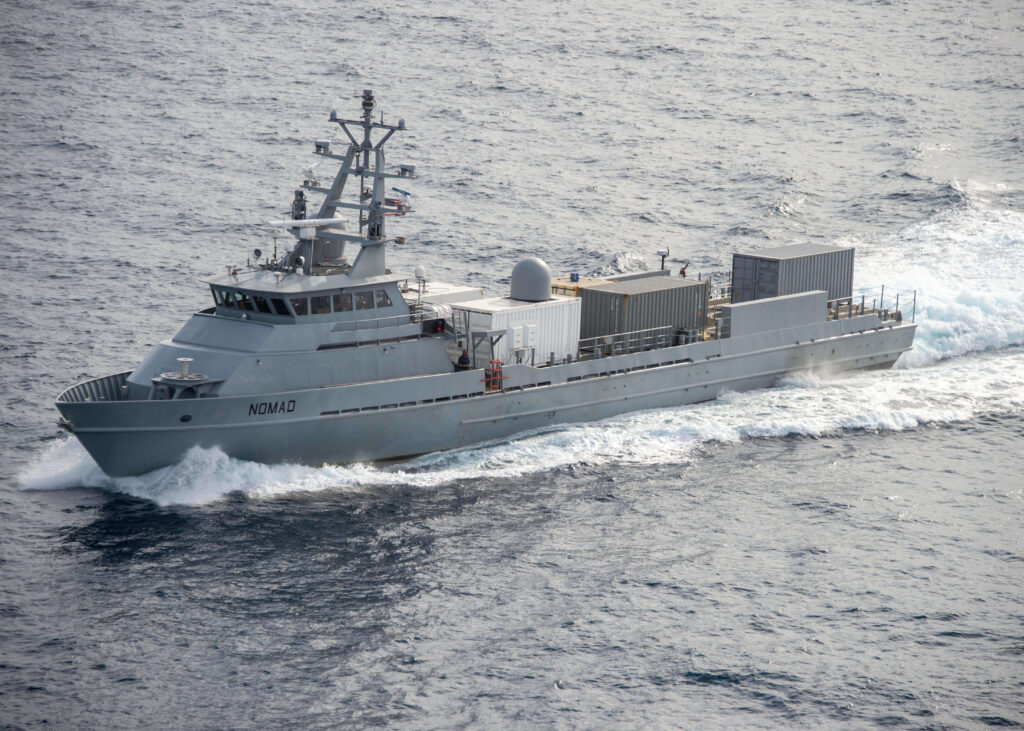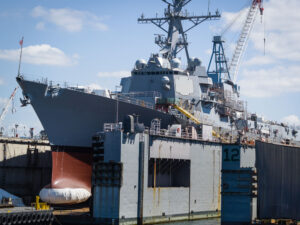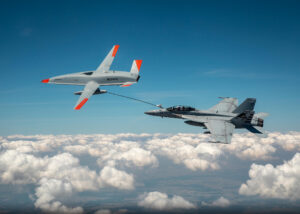The process through which U.S. weapons develop from concept to service in the field or at sea is long and complicated. It can take a decade or more from design to deployment for a new warship. This is partially due to bureaucratic roadblocks, but also a desire to thoroughly test those systems and platforms before handing them over to uniformed personnel for real-world combat operations.
Modern combat systems, especially aboard warships, are complex systems of systems, and as experienced during recent missile and drone warfare in the Red Sea, the failure to test and integrate before combat can be embarrassing and potentially fatal to the crew.
Sometimes, however, rapid fielding of prototype systems in combat is the only path forward, especially if some key aspect of the war is “on the line” and failure to act is worse than the delay in testing and fielding a system.
The United States faces the potential of peer combat at sea in as little as two years as China’s capability surges. No amount of increased shipbuilding will produce the numbers of complicated warships, submarines and aircraft needed to fight a protracted conflict in the immediate future, especially by 2027, the year that China will supposedly be ready to invade Taiwan if required.
To better prepare for that possibility, the Navy may need to produce prototypes and deploy them to combat zones like the Red Sea in order to make rapid decisions in shipbuilding acquisition. Prototype ships in combat are rare, but there is a good historical example to draw from in determining rapid developmental lessons for war at sea.
A Civil War lesson learned
The original USS Monitor of Civil War fame was very much a prototype warship sent rapidly into combat to learn immediate lessons for future acquisitions and shipbuilding. She was approved for construction on Sept. 16, 1861, thanks in part to a personal intervention on the part of President Abraham Lincoln.
Her designer, John Ericsson, worked on the cutting edge of steam engineering. Her builder, Continental Ironworks, was an industrial age, “tech startup” company, having been in business for less than a year when contracted to build Monitor the next month.
She attempted sea trials testing on Feb. 12, 1862, but suffered multiple engineering and ventilation system failures. Still, she was commissioned a little less than two weeks later even without successful sea trials. The Navy achieved successful sea trials soon thereafter.
The ship had 40 new patented pieces of gear. She departed New York City on March 6, 1862, for combat operations in Hampton Roads, Virgina, in part to protect Washington, D.C., from bombardment by the Confederate ironclad Virginia. The Navy’s experience of success with the Monitor in battle spurred further acquisition of similar warships that proved successful coastal and riverine combatants throughout the Civil War.
They were by no means perfect.
Prototypes help make the right decisions
The Monitor experience underscores the value of sending prototypes to war and learning from real world experience. Similarly, the pressing threat from China should spur the Navy to consider a prototype approach for its unmanned platforms to confirm assumptions and dispel fears.
The Navy currently has six unmanned surface vessel prototypes: the so-called “Overlord” ships Nomad, Mariner, Ranger, Vanguard and the smaller Sea Hunter and Seahawk, all members of the Navy’s “ghost fleet” of unmanned vessels. Nomad was put up for sale last year and her status remains unknown.
The current Navy acquisition plan for more such vessels remains unclear. The unmanned ship Ranger successfully launched an SM-6 missile in 2021, and a smaller unmanned vessel launched that weapon in 2023,. The service has expressed support for building a single type of unmanned ship, closer in size to the Overlord ships that can each carry four, 40-foot container payloads.The Navy wants these ships to be up to 300 feet long with a displacement of up to 2,000 tons. For comparison, the Navy’s frontline manned ship, the Arleigh Burke class destroyer, is about 509 feet long and displaces about 9,900 tons in its current variant.
Despite this announcement at this year’s Surface Navy Association event, the service has not moved ahead with acquisition plans for more unmanned vessels, and those existing ones remain assigned to the Surface Development Squadron One training command and not to an operational formation.
Instead, what the Navy should do is equip and deploy its four larger unmanned ships immediately as adjunct weapon platforms for a manned ship, perhaps in the Red Sea where they could be tested under combat conditions after which the Navy can decide to build them in large numbers or hone on one
The experiences will provide the Navy with valuable information such as how electronic connectivity between manned and unmanned ships can be maintained under combat conditions. Such a mission would also give the service a better idea of the sustainability of the unmanned ships for long periods of time away from port.
A need for escort ships
The data and experiences gleaned from the deployment to the Red Sea would allow the Navy to make smart decisions about how best to use the unmanned ships. For example, one proposal is to use the larger, Overlord-type unmanned ships as escorts and supplements to manned combatant ships. Just as the battleship seldom put to sea without an escort of destroyers to defend it from surface and undersea torpedo craft, today’s surface warships need their own escorts to aid in air, missiles and drone defense, as well as conduct antisubmarine and scouting missions.
In theory, the larger unmanned ships might carry a dozen or more missiles of their own, accessible as additional magazines for the manned warships with which they sail.
The advantage of the unmanned ships is that they could be built in vast numbers quickly and in shipyards around the United States to include those on the Great Lakes and Western Rivers. If these unmanned ships work as combat augmentation for manned ships, then the Navy might embark on a vast building program with the goal of every manned ship being a “flotilla” leader of unmanned combatants. The Dutch Navy is already planning this for their guided missile frigates.
Sending prototypes to war is certainly a risk but given the timing and need to quickly act on building choices, it’s a necessity. The Navy does not have the luxury of a long building and testing program.
Unmanned ships need to go to sea now with the operating fleet in combat conditions just as Monitor did in 1862, to make unmanned ships combat credible in the event of war with China.







